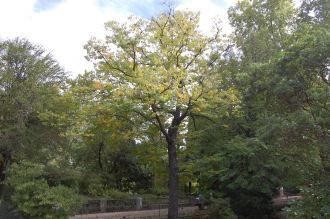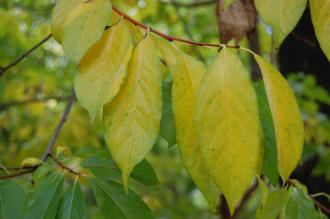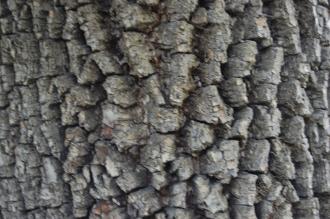
Diospyros virginiana Autumn (18/10/2014, Real Jardín Botánico de Madrid)
Position: Full sun to partial shade
Flowering period: Late spring to early summer
Soil: Moist, well drained
Eventual Height: 20m
Eventual Spread: 15m
Hardiness: 5a, 5b, 6a, 6b, 7a, 7b, 8a, 8b, 9a, 9b
Family: Ebenaceae
Diospyros virginiana is a deciduous tree with a spreading habit. Its mid to dark green leaves are ovate with entire margins, up to 13cm long and 5cm wide. Its leaves may turn orange/ yellow before they fall in autumn. Its brown/ grey bark is fissured, becoming more fissured with age. This tree is dioecious and both a male and female tree must be grown for the female to produce fruit. Its fragrant yellow/ green flowers are up to 13mm across. Its yellow/ orange fruit are ovoid up to 6cm across, ripen in October to November and are edible.

Diospyros virginiana Autumn Leaf (18/10/2014, Real Jardín Botánico de Madrid)
Diospyros virginiana, commonly known as the Diospyros virginiana, Common Persimmon, Eastern Persimmon or Sugar Plumb, is native to east and south east USA. In its native habitat it grows in clearings and as part of mixed forests.
The etymological root of the binomial name Diospyros is derived from the Greek dios meaning ‘heavenly’ and purinos meaning ‘wheat’. Virginiana is derived from the Latin meaning ‘from Virginia, USA’.
The landscape architect may find useful Diospyros virginiana as edible fruiting tree as part of a community or wild life garden.
Ecologically, Diospyros virginiana flowers are attractive to pollinating insects. Its fruit are attractive to birds and mammals (including humans).

Diospyros virginiana Autumn Bark (18/10/2014, Real Jardín Botánico de Madrid)
Diospyros virginiana prefers moist, well-drained soils. It tolerates most pH of soil. It dislikes wet soils.
Diospyros virginiana requires little maintenance.

